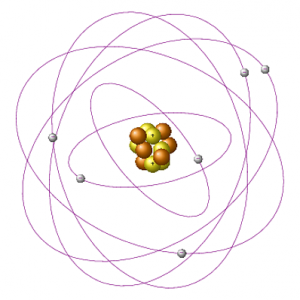I've recently learned something about electric circuits. The ideal model of circuits does ignore that electrons actually need time to pass the components of the circuit. So we introduced the "dead time model". So we added a model component for each real component that does only delay the incoming signal. But I've wondered if dead time of a cable wasn't important, too. So I thought the question would be How fast are electrons moving in a cable?, but I just realized that the question is How fast does a signal move in a wire?.
How fast are electrons moving through a wire?
If you have electric current $I$ (measured in Ampere), the wire is a cylindric conductore with a cross-sectional area of $A$, $e = -1.6021766 \cdot 10^{-19} C$ (coulombs) is the charge of an electron an $Q$ is $\frac{\text{mobile electrons}}{\text{volume}}$. $v = \frac {I}{QeA}$
According to this source, $Q = 8.5 \cdot 10^{22} \frac{1}{cm^3}$ for copper. If $I=1 A$ and if your wire has a radius of 0.5mm, you get: $v= \frac{1 A}{ 8.5 \cdot 10^{22} \frac{1}{cm^3} \cdot e \cdot ((0.5mm)^2 \cdot pi)} = 9.349 \cdot 10^{-5} \frac{m}{s} = $ (see Wolfram|Alpha).
Hmm ... seems to be very slow. Is my calculation correct?
How fast are electrical signals moving through a wire?
$v = \frac{c}{\sqrt{\mu_r \varepsilon_r}}$
where $\varepsilon_r$ is relative permittivity and $\mu_r$ is relative magnetic susceptibility.
For copper: $\mu_r = 0.999994$ $\varepsilon_r = 3$, as you can't measure permeability of metallic conductors (see "Elektromagnetische Felder und Wellen". Paul Lorrain, Dale R. Corson, François Lorrain, page 75) $v = \frac{c}{\sqrt{0.999994 \cdot 3}} = 0.577352 \cdot c$
How fast are electrons moving around an atom?
Well, first of all I have to mention, that electrons seem not to move around a nucleus as this image suggests:

A model with atomic orbitals seems to be more accurate. However, you can calulate the speed $v$ an electron would have in Bohrs model.
The centripedal force is $F_Z = \frac{m \cdot v^2}{r}$ This force pushes the electron away from the nucleus.
The coulomb-force is $F_C = \frac{e^2}{4 \pi \varepsilon_0 r^2}$ where $\varepsilon_0 \approx 8.8541 \cdot 10^{-12} \frac{F}{m}$ is permittivity.
Now you calculate: \begin{align}F_\mathrm{C} = F_\mathrm{Z} \quad &\Leftrightarrow \quad \frac{e^2}{4 \pi \varepsilon_0 r^2} = \frac{m_{e}v^2}{r}\ &\Leftrightarrow \quad v^2 = \frac{e^2}{4 \pi \varepsilon_0 r m_e} = \frac{e^2}{4 \pi \varepsilon_0 m_e} \cdot \frac{1}{r} \end{align}
Ok, we're almost there. But how do we get $r$? Well, you have to know this equation: $ m_{e} v r = n \hbar$ where $n$ is the principal quantum number and $\hbar$ is the reduced Planck constant. So you get: $\Leftrightarrow r = \frac{n \hbar}{v m_e}$
Now insert this in the equation above: \begin{align} v^2 &= \frac{e^2}{4 \pi \varepsilon_0 m_e} \cdot \frac{1}{\frac{n \hbar}{v m_e}}\ \Rightarrow v &= \frac{e^2}{4 \pi \varepsilon_0 n \hbar} \end{align}
Lets take a hydrogen nucleus ($n=1$): We get $2.19 \cdot 10^6 \frac{m}{s} \approx 7.88 \cdot 10^6 \frac{km}{h}$ (see Wolfram|Alpha). This is much less than 1% of the speed of light (which is $1.079 \cdot 10^9 \frac{km}{h}$)
Sources
Very good:
- How fast do electrons travel in an atomic orbital?
- How fast do electrons move through a conductor? → SPEED OF "ELECTRICITY"
- Explanation for speed of an electrical impulse
Not so good: